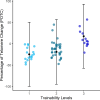Impact of trainability on telomere dynamics of pet dogs (Canis lupus familiaris): An explorative study in aging dogs
- PMID: 39908316
- PMCID: PMC11798472
- DOI: 10.1371/journal.pone.0317332
Impact of trainability on telomere dynamics of pet dogs (Canis lupus familiaris): An explorative study in aging dogs
Abstract
This research studied the impact of various factors (including social and physiological parameters) on telomere dynamics in pet dogs. Telomeres, essential for maintaining genomic integrity, undergo shortening with each cell division, leading to cellular senescence. Previous studies in humans have linked cognitive and social factors with telomere dynamics but in animals, such associations remain understudied. This study is based on a previous study, where behavioral and cognitive changes in aging pet dogs were investigated. Together with standard variables (sex, age, body weight, diet), behavioral predictors that were assessed in the "Modified Vienna Canine Cognitive Battery" were used. This study aimed to investigate the influence of these factors on telomere dynamics in aging pet dogs. The relative telomere length of 63 dogs was measured, using a qPCR method and a model selection approach was applied to assess which variables can explain the found telomere patterns. Results revealed a strong association of the behavioral factor called trainability and telomere change. Trainability was the best predictor for telomere change over time and was the only predictor having a relative variable importance (RVI) above 0.7. This finding suggests that higher trainability positively affects telomere dynamics in aging dogs and factors like age, sex, diet, and other cognitive parameters are less important. The study sheds light on the potential role of cognitive factors in canine aging and offers insights into improving the quality of life for aging dogs, but further research is needed to comprehensively understand the interplay between behavior, cognition, and telomere dynamics in dogs.
Copyright: © 2025 Weixlbraun et al. This is an open access article distributed under the terms of the Creative Commons Attribution License, which permits unrestricted use, distribution, and reproduction in any medium, provided the original author and source are credited.
Conflict of interest statement
The authors have declared that no competing interests exist.
Figures


References
MeSH terms
LinkOut - more resources
Full Text Sources
Medical

